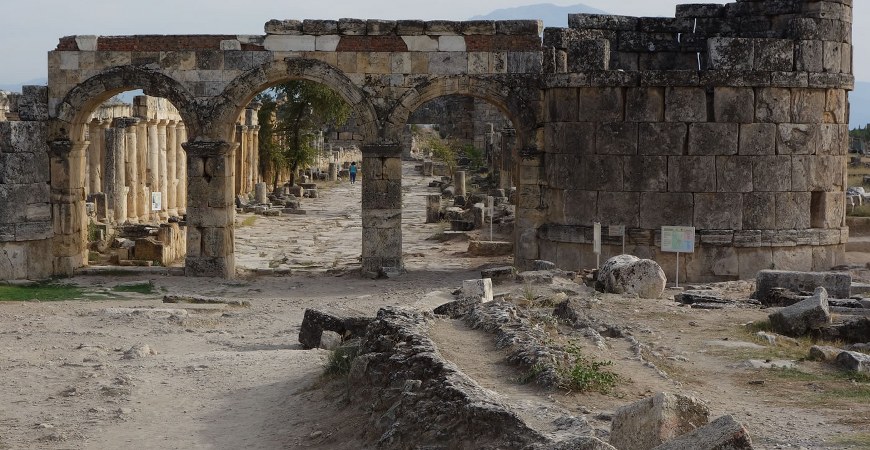
Hierapolis
It is 18 km. The name “Holy City” in the archaeological literature of the ancient city of Hierapolis in the north is due to the existence of many temples and other religious buildings known in the city. It is discussed which ancient geographical area the temple belongs to. Hierapolis is situated between the geographical location and the various historical regions surrounding it. The ancient geographers Strabon and Ptolemaios suggest that Hierapolis is a Phrygian city with close proximity to the cities of Laodikeia and Tripolis, which border the Karia region. In ancient sources, there is no information about the city’s pre-Hellenistic name. We know that there is a life in the city before being called Hierapolis because of the cult of Mother Goddess.
Despite limited information about the city’s establishment; From the Kingdom of Pergamon II. By Eumenes BC. II. YY. It is known that it was named Hierapolis because of the Amazons queen Hiera, which was founded by Bergama’s legendary founder, Telephos.
Hierapolis maintained its original doctrine by adhering to Hellenistic urbanization principles, as well as the great depression of the Roman Emperor Neron period (AD 60). The city, which is located on the earthquake zone, has suffered great damage from the Neronian earthquake and has been completely renovated. After these earthquakes, the city has lost all Hellenistic character and has a typical Roman city view. Hierapolis became a very important center in Byzantine period after Roman period. This importance, MS. IV. Being the center of Christianity from the beginning of the century (metropolis), MS. In the 80’s, Hz. It originates from the death of St. Philip, who is one of the apostles of Jesus. Hierapolis, XII. Towards the end of the century,
FRONTINUS STREET
Due to its architectural features, this street (plateia), which is thought to have been built together with the gate, was a main street of the city (AD I. Y.Y.). There is a sewer system covered with monolith cover stones in the middle of the street. There are shops, warehouses and houses with a total length of 170 m on either side of the street. In the late period (V- VI. Century), there is a series of spaces occupying the street, the street is broken and the width of the street is reduced by 8 meters. The surface of the cadden (platea) was completely covered with limestone layer (2 m height) due to its full source water. In order to open the ancient road from the limestone layer, the compressor was opened.
After the earthquake that took place in 60 years, Frontinus Street, and the hillside of the hill in the east, is organized as Hierapolis Trade Agora, which is the result of a large change in the area. This area was used before the earthquake, outside the settlement, as a necropolis and a workshop, with pottery furnaces with round planned cooking chambers, II.- İ.S. Embossed megacas were dated to the 1st century AD. II. One of the widest agora of Asia Minor is built 170 meters wide and 280 meters long in this wide area in the century. Systematic researches are started from 1979. As a result of these excavations, the plan of the monumental area is defined, some repair works and the marble blocks are arranged.
NORTH BYZANTINE DOOR
The north gate İ. S. IV. Dated to the end of the century; The North Gate symmetrically forms the monumental entrance of the city in the Byzantine Period. The door, built with a translucent material, is supported by two towers with a square plan. The elegant arch located on the bearing arkhitrave at the corner is decorated with a cross motif. It was adorned with frontal ceilings. On either side of the entrance, four consoles have been reached to protect the antique city from bad influences, apotopically standing lions, panthers, gorges with beards, possibly used in an older building.
TRITONLE FOUNTAIN HANDS
The Tritonlu Fountain is one of the two major monumental buildings in the city, along with the fountain near the Temple of Apollo. The building consists of a 70-meter-long pool opening onto the street and two curves from which niches were scraped for sculpture. The systematic excavations of the structure started in 1993; Which has fallen into the large pool and has been covered by a thick limestone layer, has allowed the reconstruction of architectural and figurative decoration elements. Especially important are; Amazzonamachia is the block where the stage is and the reliefs where the resources and rivers are personified. Dedicated to Emperor Alexander Severus, written on the architectural elements’ stylistic characters and an architrave, They make the first half of the III.yy.













